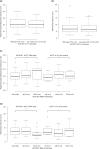Effect of SLCO1B1 Polymorphisms on High-Dose Methotrexate Clearance in Children and Young Adults With Leukemia and Lymphoblastic Lymphoma
- PMID: 32961024
- PMCID: PMC7877862
- DOI: 10.1111/cts.12879
Effect of SLCO1B1 Polymorphisms on High-Dose Methotrexate Clearance in Children and Young Adults With Leukemia and Lymphoblastic Lymphoma
Abstract
High-dose (HD) methotrexate (MTX) is a critical component of treatment for hematologic malignancies in children and young adults. Therapeutic drug monitoring is necessary due to substantial interindividual variation in MTX clearance. Common function-altering polymorphisms in SLCO1B1 (encodes OATP1B1, which transports MTX) may contribute to clearance variability. We performed pharmacokinetic modeling using data for 106 children and young adults treated with HD MTX for hematologic malignancies; of 396 total courses of HD MTX, 360 consisted of 5 g/m2 over 24 hours. We evaluated the contribution of clinical covariates and SLCO1B1 genotype (388A>G and 521T>C) to MTX clearance variability. Of the clinical covariates studied, patient weight improved the pharmacokinetic model most significantly (P < 0.001). The addition of the SLCO1B1 variants individually further improved the model (P < 0.05 for each). An interaction between these variants was suggested when both were included (P = 0.017). SLCO1B1 genotype should be considered in efforts to personalize HD MTX dosing.
© 2020 The Authors. Clinical and Translational Science published by Wiley Periodicals LLC on behalf of the American Society for Clinical Pharmacology and Therapeutics.
Conflict of interest statement
S.L.V. has received an honorarium as an invited speaker to Merck and has funding for pediatric pharmacogenomic validation from a Burroughs Wellcome Innovation in Regulatory Science Award. All other authors declared no competing interests for this work.
Figures



Similar articles
-
Systematic review: genetic polymorphisms in the pharmacokinetics of high-dose methotrexate in pediatric acute lymphoblastic leukemia patients.Cancer Chemother Pharmacol. 2024 Aug;94(2):141-155. doi: 10.1007/s00280-024-04694-0. Epub 2024 Jul 13. Cancer Chemother Pharmacol. 2024. PMID: 39002021
-
The Role of Candidate Polymorphisms in Drug Transporter Genes on High-Dose Methotrexate in the Consolidation Phase of the AIEOP-BFM ALL 2009 Protocol.Clin Transl Sci. 2025 Feb;18(2):e70136. doi: 10.1111/cts.70136. Clin Transl Sci. 2025. PMID: 39891427 Free PMC article.
-
Rare versus common variants in pharmacogenetics: SLCO1B1 variation and methotrexate disposition.Genome Res. 2012 Jan;22(1):1-8. doi: 10.1101/gr.129668.111. Epub 2011 Dec 6. Genome Res. 2012. PMID: 22147369 Free PMC article.
-
Effects of SCT genetic polymorphisms on methotrexate concentrations and toxicities in Chinese children with acute lymphoblastic leukemia.Leuk Lymphoma. 2025 Jun;66(6):1068-1078. doi: 10.1080/10428194.2025.2451059. Epub 2025 Jan 11. Leuk Lymphoma. 2025. PMID: 39798147
-
Methotrexate Disposition in Pediatric Patients with Acute Lymphoblastic Leukemia: What Have We Learnt From the Genetic Variants of Drug Transporters.Curr Pharm Des. 2019;25(6):627-634. doi: 10.2174/1381612825666190329141003. Curr Pharm Des. 2019. PMID: 30931851 Review.
Cited by
-
Population Pharmacokinetics of High-Dose Methotrexate in Chinese Pediatric Patients With Acute Lymphoblastic Leukemia.Front Pharmacol. 2021 Jul 13;12:701452. doi: 10.3389/fphar.2021.701452. eCollection 2021. Front Pharmacol. 2021. PMID: 34326772 Free PMC article.
-
Systematic Review of Pharmacogenetic Factors That Influence High-Dose Methotrexate Pharmacokinetics in Pediatric Malignancies.Cancers (Basel). 2021 Jun 7;13(11):2837. doi: 10.3390/cancers13112837. Cancers (Basel). 2021. PMID: 34200242 Free PMC article. Review.
-
Factors influencing methotrexate pharmacokinetics highlight the need for individualized dose adjustment: a systematic review.Eur J Clin Pharmacol. 2024 Jan;80(1):11-37. doi: 10.1007/s00228-023-03579-0. Epub 2023 Nov 7. Eur J Clin Pharmacol. 2024. PMID: 37934204
-
An interactive dose optimizer based on population pharmacokinetic study to guide dosing of methotrexate in Chinese patients with osteosarcoma.Cancer Chemother Pharmacol. 2024 Nov;94(5):733-745. doi: 10.1007/s00280-024-04708-x. Epub 2024 Aug 24. Cancer Chemother Pharmacol. 2024. PMID: 39180550
-
Systematic review: genetic polymorphisms in the pharmacokinetics of high-dose methotrexate in pediatric acute lymphoblastic leukemia patients.Cancer Chemother Pharmacol. 2024 Aug;94(2):141-155. doi: 10.1007/s00280-024-04694-0. Epub 2024 Jul 13. Cancer Chemother Pharmacol. 2024. PMID: 39002021
References
-
- Burkhardt, B. & Hermiston, M.L. Lymphoblastic lymphoma in children and adolescents: review of current challenges and future opportunities. Br. J. Haematol 185, 1158–1170 (2019). - PubMed
-
- Termuhlen, A.M. et al Disseminated lymphoblastic lymphoma in children and adolescents: results of the COG A5971 trial: A report from the Children's Oncology Group. Br. J. Haematol. 162, 792–801 (2013). - PubMed
-
- Seidel, H. et al Variability in methotrexate serum and cerebrospinal fluid pharmacokinetics in children with acute lymphocytic leukemia: relation to assay methodology and physiological variables. Leuk. Res. 24, 193–199 (2000). - PubMed
Publication types
MeSH terms
Substances
Grants and funding
LinkOut - more resources
Full Text Sources
Medical

